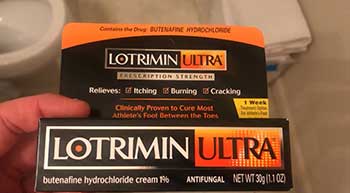If you’re an active person, you may have experienced the irritation and discomfort of fungal infections like athlete’s foot or jock itch. Both conditions are caused by the same family of fungi called dermatophytes, which feed on keratin, a protein found in skin, nails, and hair.
While their causes are similar, athlete’s foot and jock itch have some key differences. Understanding those differences can help you choose the right over-the-counter antifungal cream to get relief fast.
A Brief Comparison Table
| Feature | Athlete’s Foot | Jock Itch |
| Location of infection | Feet, especially between the toes | Groin, upper thighs, buttocks |
| Causes | Tight, sweaty footwear | Friction from restrictive clothing |
| Symptoms | Itchy, red rash with scaling; wet blisters; cracked skin | Itchy, red rash with raised scaly edges |
| OTC Treatment Tips | Medicated powders; sprays | Creams, sprays for rubbing into folds |
| Prevention Tips | Wear clean cotton socks; wash and dry feet thoroughly; use antifungal powder | Shower after sweating; wear loose clothes; apply antifungal powder |
| Lotrimin Ultra Format | Spray dries quickly with no residue | Cream adheres well to groin folds |
What Is Athlete’s Foot?

Athlete’s foot, also known as tinea pedis, most often occurs between the toes and on the soles of the feet. This fungal infection causes redness, scaling, itching, and burning. Blisters and cracked skin may also occur.
Athlete’s foot thrives in the moist, warm environment of shoes and socks. It spreads easily in communal areas like locker rooms, pools, and showers. Active people who don’t dry their feet thoroughly after bathing or activity are especially prone to this stubborn infection.
What Is Jock Itch?
Jock itch, also called tinea cruris, is a fungal infection of the groin area, upper thighs and buttocks. It causes a red, itchy rash with scaly raised borders.
The rash often forms in the folds of overlapping skin. Moisture, friction, and lack of ventilation provide the perfect breeding ground for jock itch. It is common in athletes, but anyone can get it.
Wearing tight underwear, sweaty athletic supporters, and damp workout clothes increases your risk. Jock itch can spread through skin-to-skin contact or by touching contaminated clothes and surfaces.
Comparing Causes, Locations, And Symptoms
While both athlete’s foot and jock itch stem from dermatophyte fungi, there are some clear differences:
- Location: Athlete’s foot affects the feet, especially between the toes. Jock itch occurs in the groin and upper thighs.
- Causes: Tight, sweaty footwear encourages athlete’s foot fungi. Friction in the groin area from restrictive clothing leads to jock itch.
- Symptoms: Both cause itchy, red rashes with scaling. Athlete’s foot may also cause wet blisters and cracks in the skin. Jock itch leads to raised, scaly edges.
So while the underlying cause is the same, the location, triggers, and symptoms differ. Keeping these differences in mind will help you find the right treatment.
Treating Athlete’s Foot Vs. Jock Itch
There are many effective over-the-counter treatments for fungal skin infections. Most contain an antifungal ingredient such as miconazole, clotrimazole, terbinafine, or butenafine.

These ingredients stop fungi from growing by damaging their cell membranes. Applied consistently, they clear up most athlete’s foot and jock itch.
Some key considerations for treatment:
- Medicated powders help keep feet dry to combat athlete’s foot.
- Creams and sprays are better for rubbing into the groin for jock itch relief.
- Combination formulas fight infection and relieve itching.
No matter where symptoms occur, good hygiene is critical:
- Wash the affected area and dry thoroughly before applying medication.
- Apply antifungal cream to all infected areas 1-2 times per day as directed.
- If feet are infected, wear clean cotton socks and avoid tight shoes.
- Wear loose, breathable clothing and avoid skin overlap in the groin.
- Continue using the antifungal for 1-2 weeks after symptoms resolve to prevent recurrence.
Lotrimin Ultra For Athlete’s Foot And Jock Itch
A popular over-the-counter choice for fungal skin infections is Lotrimin Ultra. This topical antifungal cream contains 1% butenafine hydrochloride.
Here’s how it stacks up for athlete’s foot Vs. jock itch:
Athlete’s Foot
- The spray format makes it easy to apply between toes.
- Dries quickly with no mess or residue.
- Provides 24-hour symptom relief.
Jock Itch
- Contains menthol and benzyl alcohol to soothe itch.
- The cream format adheres well to groin folds.
- Relieves symptoms for 24 hours.
The key antifungal in Lotrimin Ultra, butenafine, disrupts fungal cell functions. Research shows it is highly effective against athlete’s foot and jock itch.
A 2011 study found it cleared tinea cruris in 70% of patients, compared to just 45% treated with placebo. It’s also proven more effective for athlete’s foot than older antifungals like clotrimazole.
Benefits of using Lotrimin Ultra for these fungal infections include:
- Begins relieving itch and burning in just 1 day.
- Kills fungi at the source for long-lasting relief.
- Colorless, odorless, and non-greasy.
- Safe for daily use over 2 weeks or as directed.
However, Lotrimin Ultra should not be used by those allergic to butenafine or pregnant/nursing women without consulting a doctor.
While generally well-tolerated, itching, burning, stinging, or rash may occur. Discontinue use if severe irritation develops.
Also Read: Is GenuTrain Better Than Sports Knee Supports?
Preventing Recurrence
With topical antifungals, most cases of athlete’s foot and jock itch clear within 2 weeks. But without preventive measures, reinfection is common.
Follow these tips to avoid repeating the frustrating cycle:
For Athlete’s Foot Prevention
- Wear clean cotton socks and rotate shoes daily.
- Wash feet daily, scrubbing between toes. Dry thoroughly, especially between toes.
- Apply antifungal powder to feet and inside shoes regularly.
- Wear flip flops in public showers and locker rooms.
- Disinfect bathtubs and showers after use.
Watch a nice video on it!
For Jock Itch Prevention
- Shower immediately after exercise or sweating. Wash the groin area and dry thoroughly.
- Wear loose, breathable underwear and clothes. Avoid tight exercise gear.
- Apply antifungal powder to the groin before working out.
- Use unscented gentle cleansers and laundry detergent.
- Disinfect bathroom surfaces and laundry hampers regularly.
Making smart lifestyle choices reduces recurrence. But if symptoms return after 2-4 weeks, visit a dermatologist. A prescription oral antifungal may be needed.
Lotrimin Ultra Vs. Other Leading Brands
Lotrimin Ultra isn’t the only over-the-counter choice for fungal relief. Some other top brands include:
Lamisil AT uses terbinafine hydrochloride to fight fungal growth. It offers creams, gels, sprays and powders to treat athlete’s foot, jock itch and ringworm.
Tinactin contains tolnafate as the active ingredient. Its powders and sprays target athlete’s foot while creams treat jock itch.
Lotrimin AF contains clotrimazole rather than butenafine. It comes in cream, liquid and powder forms to combat fungal infections.
While all these products can effectively treat athlete’s foot and jock itch, Lotrimin Ultra offers a few advantages:
- Contains butenafine, a newer generation antifungal.
- Available as a spray or cream for foot and groin symptoms.
- Relieves itching fast.
- Absorbs quickly with less residue.
- Gets positive reviews for preventing recurrence.
- Typically slightly cheaper than comparable name brands.
Ultimately the choice comes down to personal preference. Try different products to find the consistency and application method you prefer. The key is using an over-the-counter antifungal consistently and as directed.
Also Read: Comparison Between Shock Doctor 872 and 875
Frequently Asked Questions (FAQ)
Yes, Lotrimin Ultra cream is effective at treating both athlete’s foot and jock itch. The key antifungal ingredient butenafine hydrochloride works on fungal infections anywhere on the body.
Most over-the-counter antifungals made for athlete’s foot, like sprays and powders, can also treat jock itch. As long as the active ingredient is an antifungal like butenafine, miconazole or tolnaftate, the medication will clear up fungal infections in the groin area.
Butenafine hydrochloride is more effective for jock itch relief. In studies, creams with butenafine like Lotrimin Ultra perform better against fungal growth than those with clotrimazole. Butenafine also relieves itching and burning faster.
Yes, Lotrimin Ultra cream can be safely applied to the groin area. Make sure to fully dry the area first. Apply a thin layer over all infected skin in the groin folds twice daily or as directed until the rash resolves. But avoid using the spray format on the groin or genitals.
Also Read: Differences Between Penetrex And Voltaren.
The Bottom Line
While athlete’s foot and jock itch share a fungal cause, their location and symptoms differ. Topical antifungals like Lotrimin Ultra can treat both by disrupting the fungi’s cell membranes.
Look for creams, sprays or powders with butenafine, terbinafine, miconazole or tolnaftate. Treat the infection diligently for 2 full weeks. Combine with preventive steps like keeping feet and groin dry, wearing breathable clothes, and disinfecting surfaces.
With smart treatment and prevention, these frustrating fungal infections don’t have to keep returning. An over-the-counter antifungal like Lotrimin Ultra can help keep you active and comfortable.
